Is Model United Nations supposed to be a simulation of the real United Nations?
To someone outside of the MUN community, the answer may seem like an obvious yes — this is, after all, the “model” UN. But to those who are part of the MUN community, you know that the answer is not so obvious — this is actually one of the biggest questions facing the activity.
MUN may have strictly been a simulation of the UN when it first started over sixty years ago (longer, if you count the Model League of Nations). But MUN conferences today feature simulations of non-UN-related organizations. If you read this summer’s New York Times article on “The Dog-Eat-Dog World of Model UN,” then you know how far away Model UN has gotten from being a strict simulation of the real UN.
The overwhelming majority of MUN conferences and committees, however, are still simulations of UN bodies and related organizations. But if you have ever researched how your committee work, or have actually studied UN practices and procedures, then you know that even these “traditional” MUN conferences and committees do not simulate the UN accurately. The UN itself pointed this out in its response to the New York Times article.
Questions about the differences between Model UN and the real UN have existed for a long time. Questions like: why should Model UN simulate the real UN? How would MUN conferences simulate the UN more accurately? In fact, what are actual UN practices and procedures?
And these are the questions 100+ MUNers from around the world came together to discuss last month at the United Nations.

Enter the UN4MUN Workshop
Last month, KFC and I attended the UN4MUN Workshop hosted by the United Nations Department of Public Information (UNDPI) at UN Headquarters in New York City from August 26-29, 2013.
About 100 people participated, coming from as far away as India, Bangladesh, Paraguay, Ghana, Kenya, the Netherlands, Iran, Uzbekistan, Azerbaijan, and Aruba, as well as New York City and across the United States. Most participants were university students involved in organizing MUN conferences in their home countries, but there were also teachers and organizers of high school, middle school, and even elementary school MUN conferences.
Led by UNDPI organizers Nathalie Leroy and Bill Yotive, the objective of the workshop was to teach participants about UN practices and procedures — and how they differ significantly from current MUN conferences. The workshop was structured around small group discussions on the key questions on the differences between the real UN and Model UN. Discussions were followed by presentations from UN officials on real UN practices and procedures, including Deputy Secretary-General Jan Eliasson.
The scope of our discussions mainly focused on the General Assembly, although GA practices and procedures are followed at other UN conferences and meetings, and we also discussed the Security Council. The workshop also intended to focus on university-level MUN, but we also discussed high school, middle school, even primary school-level MUN.
The discussions allowed participants to learn the differences between Model UN conferences across the globe, and it was wonderful to see how diverse an activity MUN actually is. The presentations showed us how the UN actually operates, which yielded several surprising insights; I was surprised to learn how the founding principles written in the UN Charter, such as sovereignty and equality, are actually applied today. And between the discussions and panels over the course of 4 days, we could see many differences between Model UN and the real UN, and 4 big differences in particular.
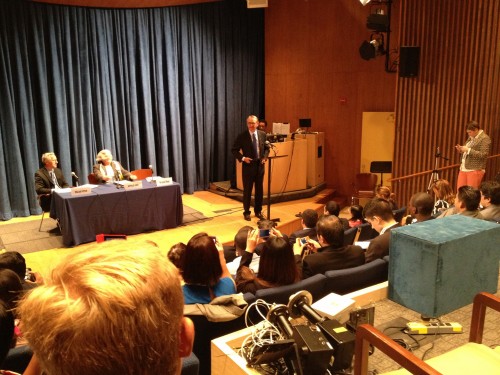
Big Difference #1: Leadership Structure
At nearly all Model UN conferences, the Chair and other committee leadership positions (Vice Chairs, etc.) are appointed by the hosting school or organization. They are referred to as the Dais, and they are responsible for committee substance (e.g. background guides) and procedure (e.g. running committee). Chairs are viewed as an all-powerful authority figure in committee; they are typically older and from higher grade levels (university students chairing a committee of high school students, for example). This description of the Chair may seem like such an obvious and needlessly stated fact of Model UN — yet it is actually contradictory to the founding principles of the UN.
In the UN, Chairs and Vice Chairs are elected by the member states at the beginning of the annual General Assembly session in September. They are referred to as the Bureau and they are active in building consensus (i.e. merging resolutions). GA Plenary is led by a President, not a Chair. And all of the leadership positions are distributed regionally; every regional group is allocated a certain number of Chair and Vice Chair positions, and the member states of that group decide who gets the position.
And the Bureau (i.e. Chairs and Vice Chairs) is not solely responsible for substance and procedure. Each committee has a Secretary — someone from the UN Secretariat who is under the chain of command of the Secretary-General — who supports the Chair with running committee. The Secretary prepares scripts ahead of the committee meeting for Chairs to follow. The Secretary also prepares presentations for the committee and determines whether and how resolutions impact the UN’s budget.
In UN committees, the Chair still has power and authority, but ultimately the Chair serves the member states. The Chair is a delegate elected by fellow delegates, and the Chair is obligated to them. For example, the Chair does not rule motions “dilatory” — every point or motion raised by a member state is considered seriously. This practice of the Chair being a servant of the member states reflects one of the founding principles of the UN: sovereignty. But this also means that the current practice of MUN conferences, where the Chair is appointed and viewed as a higher authority than delegates and the member states they represent, actually contradicts the spirit of the UN.
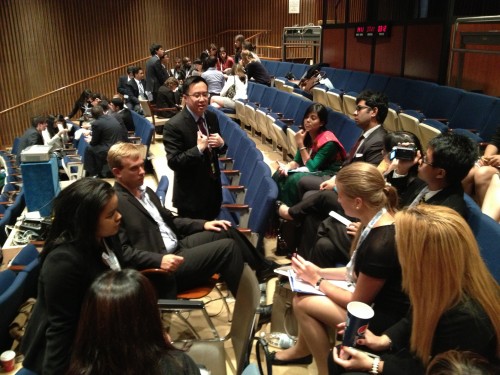
Big Difference #2: Rules of Procedure
Many MUN conferences have Rules of Procedure (ROP). Sometimes they are referred to as parliamentary procedure, or they claim to be modified from Robert’s Rules of Order. Most conferences have various points that delegates can raise, including the ubiquitous “point of (parliamentary) inquiry.” At some conferences, motions need to be seconded, as they are at various legislative bodies. New delegates and advisors often view ROP as one of the biggest obstacles to learning MUN. Experienced delegates attempt to use ROP to their advantage (motioning for moderated caucus, for example, in order to gain speaking time).
Like the Chair, this description of ROP may also be taken for granted by MUN conferences. Many are aware that ROP differs from conference to conference (and especially so between American-style and THIMUN-style conferences). Yet current ROP at MUN conferences gets parts of the UN backwards. Firstly, the UN is not a parliament and does not use parliamentary procedure. The UN follows its own procedure that reflects its founding principles. UN ROP Procedure is actually simpler than ROP at most MUN conferences.
There is only one point: Point of Order. All other points (Inquiry, Information, Personal Privilege, etc.) fall under Point of Order. To make a motion, delegates make a “T” with their placard and their hand. And there is no seconding of motions — seconding actually contradicts the principle of sovereignty, because it would mean that a member state could not make a motion on its own and needs another member state’s permission.
At North American conferences, debate goes back and forth between speakers list, unmoderated caucus, and moderated caucus. At THIMUN conferences, debate typically starts with lobbying, moves into speakers list, and then multiple resolutions are debated one at a time. Both formats are guided heavily by ROP. But at UN conferences, the real work takes place outside the confines of ROP. Delegates have “formal meetings” that are guided by ROP — these are essentially the equivalent of a speakers list. Then they meet during “informal meetings” that do not have to follow any ROP — these are like unmoderated caucus or lobbying.
These “informal meetings” take up the vast majority of conference time. Think of it like one long unmoderated caucus or lobbying session for the rest of committee until a single resolution has been merged together and ready to be adopted by consensus. Therefore, motions are not even in order for most of the committee time, nor is there formal debate on each resolution.
The right of reply is used at UN conferences, but it’s not about insults; it is actually used to substantively reply to a speech. Delegates only have one chance to make a formal speech on each agenda item, unless they request a right of reply; if granted, they are allowed to speak at the end of the day.
On resolutions, there is no minimum number of sponsors and no such thing as signatories — these MUN practices actually violate the UN’s founding principle of equality among sovereign states. In the UN, if a member state submits a resolution, that resolution is taken seriously, no matter how big or small, rich or poor the state is, and no matter how many states support the resolution.
There is no such thing as friendly versus unfriendly amendments. Usually every country is part of the same resolution and negotiates all the clauses up front before taking action (voting or adopting by consensus) on them.
Here’s a big procedural difference: almost all MUN conferences vote on motions and resolutions. Yet in the GA and other UN bodies, voting is avoided. Motions and resolutions are usually adopted by consensus. During informal meetings, delegates identify differences between draft resolutions and attempt to compromise in order to achieve consensus. When it’s time to “take action” (i.e. vote) on a motion or resolution, the Chair says, “If there are no objections, this resolution will now be adopted by consensus.”
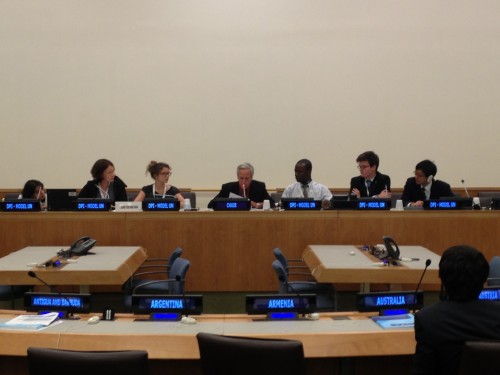
Big Difference #3: Resolution Negotiations
At MUN conferences, when delegates start writing resolutions during unmoderated caucus or lobbying, they try to find delegates with similar policies, although oftentimes they look to work with friends or familiar faces, or any delegates sitting or standing next to them. Most resolutions are vague when it comes to funding their solutions; at THIMUN, discussions of funding are actually prohibited according to their ROP. At North American-style conference (i.e. those that have caucusing), resolutions must be written at the conference — “pre-written resolutions” are considered cheating (although pre-written resolutions are okay at THIMUN conferences). And once a resolution has been drafted, the sponsors attempt to get “their” resolution passed by seeking support from a majority of the committee’s delegates.
But in the real UN, member states meet in regional groups first to develop common positions on agenda items and topics. The member states of each regional group attempt to reach consensus on agenda items and draft resolutions. Regional groups are a big part of UN practices, as many practices are determined by region, including who can be President of the GA, Chairs, Vice Chairs, and Secretary-General.
Discussing how a resolution impacts the UN’s budget is a big part of negotiating resolutions. When resolutions are being discussed, the Secretary determines how the resolution might impact the budget; these are called “programme budget implications” (PBIs). The 5th Main Committee of the GA (Administrative and Budgetary) reviews PBIs across the resolutions that are passed in other committees and makes a recommendation to the GA Plenary.
And “pre-written resolutions” are expected at UN meetings. In fact, when a member state submits an item (i.e. topic) to be considered on the agenda, they typically include a sample resolution. Having the sample resolution facilitates discussion. One or a small group of member states may have a strong interested in an agenda item, and they will be responsible for pushing debate forward by suggesting draft resolutions before formal meetings and working on them during informal meetings.
But the biggest difference between Model UN and real UN when it comes to negotiating resolutions is the UN’s focus on building consensus. As mentioned above, most resolutions are not even voted on; according to the UN4MUN workshop presenters, 80% of GA resolutions are adopted by consensus. This goal of consensus at the UN fosters a diplomatic culture that feels very different from the oftentimes competitive culture of MUN conferences.
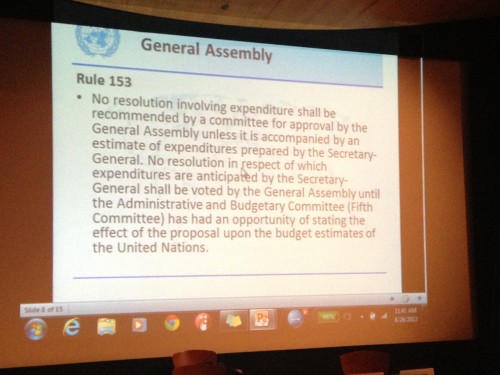
Big Difference #4: Educational Purpose
For the UN, the purpose of Model UN is to simulate the real UN. This means representing the member states that comprise the UN, discussing the same agenda items that the UN discusses, and simulating accurate practices and procedures followed at the UN.
Conversely, this also means MUN should not teach students what the UN is not about; for example, having appointed chairs in positions of higher authority communicates to delegates that this is a UN practice, when it is actually contradictory to the very principles on which the UN was founded.
But MUN conferences don’t necessarily share this purpose. Many conferences want to teach students not just about the UN, but about international relations, current events, and history — the UN is a significant part of that, but not the biggest part.
Conferences are not only focused on simulating the UN — they also simulate non-UN bodies, including regional organizations, national cabinets, and crisis committees, which have their own practices and procedures.
And conferences want to teach students leadership skills — such as research, public speaking, and negotiation — and current MUN practices and procedures already facilitate that, even if it’s not an accurate simulation of how the UN operates.
However, many conferences do want to teach students about the UN and they would use real UN practices and procedures if they knew how to implement them.
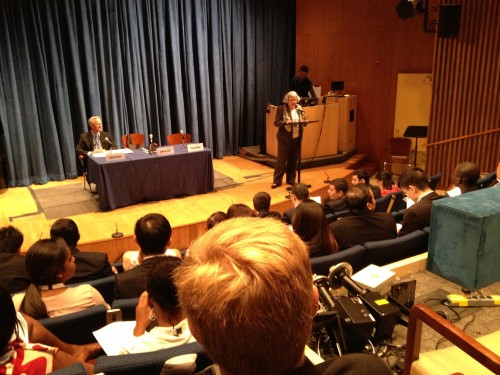
Further Questions
It was an eye-opening experience to discover and discuss these differences over the course of the UN4MUN Workshop. But each realization also led to many more questions:
-
Would MUN conferences “give up” the ability to appoint Chairs? How would the elections process work? Would high school and middle school students be able to chair? Would having peer-elected chairs invite chaos into the committee room?
-
Would MUN conferences change their rules of procedure? If their current ROP is already working, why change it? If ROP is not being followed during informal meetings, won’t the committee descend into disorder?
-
Is consensus possible at MUN conferences? The real UN has weeks and months to negotiate — Model UN conferences take place over one or a few days — is there enough time to build consensus? Real UN delegates are experts who spend years working on the same issues — Model UN delegates are students who are just beginning to explore these complex issues — is there a deep enough understanding to allow consensus? And for MUN conferences that give awards, delegates are often trying to “win” by getting “their” resolution passed and avoiding mergers — is consensus possible within a culture of awards?
-
Are accurately simulated practices and procedures actually important to MUN conferences? How would accurate procedures would be implemented, especially large conferences with well-established practices and long-running traditions? Should new conferences adopt accurate procedures, even if this means delegates attending their conference would encounter the currently popular — and completely different — procedures at other conferences?
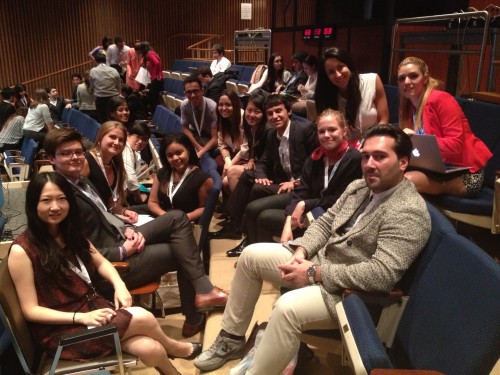
Flashback: WFUNA Korea Camp
Coming into the UN4MUN Workshop, KFC and I actually had experience working with UN4MUN Procedures (KFC attended the workshop last year as well). In early August, we served as Head Trainers at an MUN Camp in Korea hosted by the World Federation of United Nations Associations (WFUNA), which requested that delegates learn procedures more closely in line with the UN. We shared our Korea experience at the UN4MUN workshop, which showed us that UN4MUN Procedure was very possible.
At the end of the Korea Camp, KFC and I organized a 1-day MUN conference, and we ran both high school and middle school-level committees, each with about 25 delegates. The day before the conference, delegates in both committees elected a President of the General Assembly, a High School Committee Chair, and a Middle School Committee Chair. During the conference, KFC and I served as Secretaries, and we provided Chairs with scripts to follow for running their committees. We simplified the flow of debate, and had all opening speeches take place during Formal Meeting — meaning every delegate got a chance to speak — and then proceeded into one long Informal Meeting (essentially unmoderated caucus or lobbying).
I served as Secretary for the middle school committee, which discussed Sustainable Energy. Before the committee began, I wondered if a middle school delegate would be able to chair the Formal Meeting. I also wondered if the Informal Meeting would go on for too long, leaving delegates to be disengaged. But the results pleasantly surprised me.
The middle school Chair was capable for managing a committee of his peers, with the help of his script and guidance from me sitting beside him. During the Informal Meeting, delegates first formed separate resolution groups, as it typical during unmoderated caucuses or lobbying sessions. But then they did something that surprised me: they all moved into a breakout room, re-arranging chairs to form one big group, and they started negotiating a single draft resolution.
Although ROP was no longer being enforced, the Chair still fell into his role of moderating the discussion and, more importantly, building consensus. They went down each clause (or paragraph) of the draft resolution line by line. And by the end of the 1-day conference, they adopted their resolution by consensus. This middle school committee essentially achieved the objectives of UN4MUN Procedure without realizing it.
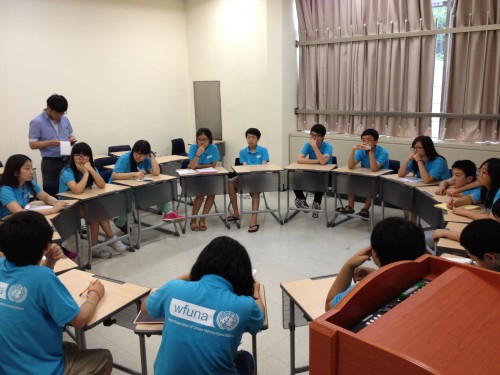
KFC ran the high school committee, which had the more controversial topic of Nuclear Non-Proliferation. Delegates had to meet by regional blocs first which forced them to tackle the issue up front because their bloc did not necessarily consist of policy allies. For example, Pakistan and Iran had to work with Japan and South Korea on the same resolution. The consensus built within a bloc made it easier for the Chair to eventually facilitate mergers between all regional blocs until there was one resolution. North Korea did not agree with the final draft though and was the only delegate to motion for a vote, which to break consensus. Nevertheless, Bill Yotive at UNDPI said it would be expected for consensus to be more difficult to achieve for controversial topics and in real life a minority of controversial resolutions are taken to a vote or taken to no action.
Recommendations for MUN Conferences
UNDPI is increasing its efforts to educate participants and change the procedures and cultures of Model UN conferences to be more accurate. From their point of view, they are merely sharing what they do in real life and would like simulations of their organization to be accurate. To that end, they are developing resources to help conferences implement more accurate practices and procedures. Check out the UN4MUN website for more information.
For those who are interested in adopting the official UN rules, I’m sure you have many questions and perhaps even some resistance to implementing the procedures. KFC and I would like to share our recommendations, based on discussions at the UN4MUN Workshop and our experiences at the WFUNA Korea Camp, for conferences that are interested in adopting for more accurate practices and procedures:
-
Leadership Structure: Allow delegates to elect fellow delegates as Chairs and Vice Chairs before the conference or at the beginning session. They should be referred to as the Bureau, not the Dais. And students from the hosting school or organization should serve as Secretaries who assist the Bureau with procedural guidance and substantive expertise.
-
Rules of Procedure: Simplify the procedure. Combine all points into a single Point of Order. Instead of calling negotiations “caucusing” or “lobbying,” call them “informal meeting.” The Flow of Debate just has 3 phases: Formal Meeting (speakers list), Informal Meeting (unmod or lobbying), and Action Phase (voting or adoption by consensus).
-
Resolution Negotiations: At the beginning of the conference, have delegates meet in regional groups and combine their resolutions into a resolution. Vice Chairs should lead regional group discussions. Then meet in committees and aim to produce one resolution and adopt it by consensus. The Chairs and Vice Chairs should be involved in discussions and facilitating resolution mergers.
-
Educational Purpose: Before changing anything, decide as a conference how much you value accuracy. If you want to adopt more accurate practices and procedures, you don’t have to change everything all at once. Start with small changes, like using the correct UN terms (“informal meeting” instead of caucusing or lobbying, for example), before moving on to big changes like implementing elections. And you can experiment — start with implementing changes to one committee first to see how it works, then roll out the changes conference-wide in future years.
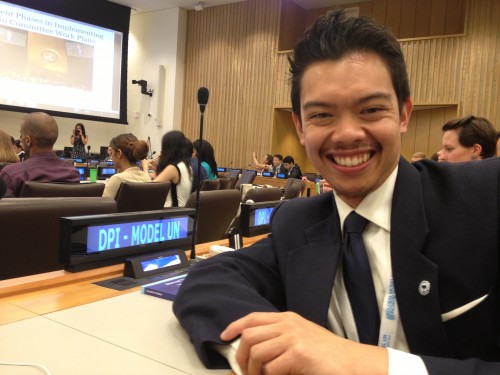
Despite the big differences between Model UN and the real UN, the things that truly matter remain the same. Model UN is still a way to show students the world and their role in it. Model UN is still a vehicle for teaching global leadership and lifelong skills. Model UN is still a community of students and teachers that attracts the best and the brightest from every school and every country. These truths are why the real UN is “for” Model UN — and on that, I believe we have a consensus.
Do you think Model UN should adopt the practices and procedures of the real UN? How would you implement this in your MUN conference? Leave a comment below!

